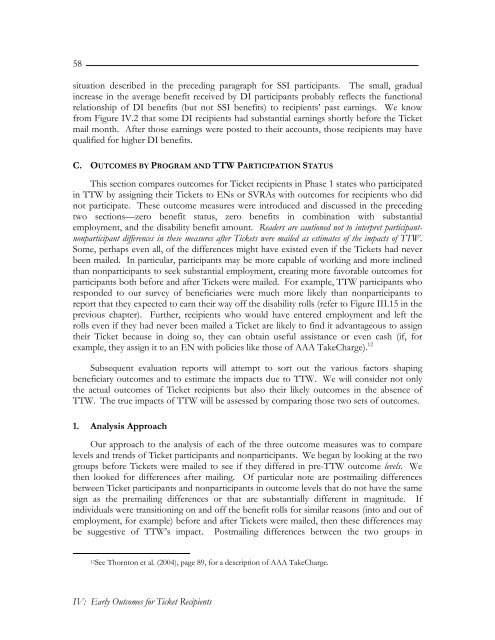Evaluation of the Ticket to Work Program, Implementation ...
Evaluation of the Ticket to Work Program, Implementation ...
Evaluation of the Ticket to Work Program, Implementation ...
You also want an ePaper? Increase the reach of your titles
YUMPU automatically turns print PDFs into web optimized ePapers that Google loves.
58situation described in <strong>the</strong> preceding paragraph for SSI participants. The small, gradualincrease in <strong>the</strong> average benefit received by DI participants probably reflects <strong>the</strong> functionalrelationship <strong>of</strong> DI benefits (but not SSI benefits) <strong>to</strong> recipients’ past earnings. We knowfrom Figure IV.2 that some DI recipients had substantial earnings shortly before <strong>the</strong> <strong>Ticket</strong>mail month. After those earnings were posted <strong>to</strong> <strong>the</strong>ir accounts, those recipients may havequalified for higher DI benefits.C. OUTCOMES BY PROGRAM AND TTW PARTICIPATION STATUSThis section compares outcomes for <strong>Ticket</strong> recipients in Phase 1 states who participatedin TTW by assigning <strong>the</strong>ir <strong>Ticket</strong>s <strong>to</strong> ENs or SVRAs with outcomes for recipients who didnot participate. These outcome measures were introduced and discussed in <strong>the</strong> precedingtwo sections—zero benefit status, zero benefits in combination with substantialemployment, and <strong>the</strong> disability benefit amount. Readers are cautioned not <strong>to</strong> interpret participantnonparticipantdifferences in <strong>the</strong>se measures after <strong>Ticket</strong>s were mailed as estimates <strong>of</strong> <strong>the</strong> impacts <strong>of</strong> TTW.Some, perhaps even all, <strong>of</strong> <strong>the</strong> differences might have existed even if <strong>the</strong> <strong>Ticket</strong>s had neverbeen mailed. In particular, participants may be more capable <strong>of</strong> working and more inclinedthan nonparticipants <strong>to</strong> seek substantial employment, creating more favorable outcomes forparticipants both before and after <strong>Ticket</strong>s were mailed. For example, TTW participants whoresponded <strong>to</strong> our survey <strong>of</strong> beneficiaries were much more likely than nonparticipants <strong>to</strong>report that <strong>the</strong>y expected <strong>to</strong> earn <strong>the</strong>ir way <strong>of</strong>f <strong>the</strong> disability rolls (refer <strong>to</strong> Figure III.15 in <strong>the</strong>previous chapter). Fur<strong>the</strong>r, recipients who would have entered employment and left <strong>the</strong>rolls even if <strong>the</strong>y had never been mailed a <strong>Ticket</strong> are likely <strong>to</strong> find it advantageous <strong>to</strong> assign<strong>the</strong>ir <strong>Ticket</strong> because in doing so, <strong>the</strong>y can obtain useful assistance or even cash (if, forexample, <strong>the</strong>y assign it <strong>to</strong> an EN with policies like those <strong>of</strong> AAA TakeCharge). 12Subsequent evaluation reports will attempt <strong>to</strong> sort out <strong>the</strong> various fac<strong>to</strong>rs shapingbeneficiary outcomes and <strong>to</strong> estimate <strong>the</strong> impacts due <strong>to</strong> TTW. We will consider not only<strong>the</strong> actual outcomes <strong>of</strong> <strong>Ticket</strong> recipients but also <strong>the</strong>ir likely outcomes in <strong>the</strong> absence <strong>of</strong>TTW. The true impacts <strong>of</strong> TTW will be assessed by comparing those two sets <strong>of</strong> outcomes.1. Analysis ApproachOur approach <strong>to</strong> <strong>the</strong> analysis <strong>of</strong> each <strong>of</strong> <strong>the</strong> three outcome measures was <strong>to</strong> comparelevels and trends <strong>of</strong> <strong>Ticket</strong> participants and nonparticipants. We began by looking at <strong>the</strong> twogroups before <strong>Ticket</strong>s were mailed <strong>to</strong> see if <strong>the</strong>y differed in pre-TTW outcome levels. We<strong>the</strong>n looked for differences after mailing. Of particular note are postmailing differencesbetween <strong>Ticket</strong> participants and nonparticipants in outcome levels that do not have <strong>the</strong> samesign as <strong>the</strong> premailing differences or that are substantially different in magnitude. Ifindividuals were transitioning on and <strong>of</strong>f <strong>the</strong> benefit rolls for similar reasons (in<strong>to</strong> and out <strong>of</strong>employment, for example) before and after <strong>Ticket</strong>s were mailed, <strong>the</strong>n <strong>the</strong>se differences maybe suggestive <strong>of</strong> TTW’s impact. Postmailing differences between <strong>the</strong> two groups in12See Thorn<strong>to</strong>n et al. (2004), page 89, for a description <strong>of</strong> AAA TakeCharge.IV: Early Outcomes for <strong>Ticket</strong> Recipients
















